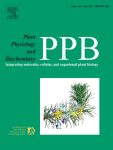Ver ítem
- xmlui.general.dspace_homeCentros Regionales y EEAsCentro Regional Patagonia SurEEA Santa CruzArtículos científicosxmlui.ArtifactBrowser.ItemViewer.trail
- Inicio
- Centros Regionales y EEAs
- Centro Regional Patagonia Sur
- EEA Santa Cruz
- Artículos científicos
- Ver ítem
Leaf wettability, anatomy and ultra-structure of Nothofagus antarctica and N. betuloides grown under a CO2 enriched atmosphere
Resumen
Increasing CO2 air concentration may affect wettability, anatomy and ultra-structure of leaves of Patagonian forest species, evergreen and deciduous plants potentially responding differently to such CO2 increases. In this study, we analysed the wettability, anatomy and ultra-structure of leaves of Nothofagus antarctica (deciduous) and N. betuloides (evergreen) grown under high CO2 concentrations. Leaf wettability was affected by increasing CO2, in
[ver mas...]
Increasing CO2 air concentration may affect wettability, anatomy and ultra-structure of leaves of Patagonian forest species, evergreen and deciduous plants potentially responding differently to such CO2 increases. In this study, we analysed the wettability, anatomy and ultra-structure of leaves of Nothofagus antarctica (deciduous) and N. betuloides (evergreen) grown under high CO2 concentrations. Leaf wettability was affected by increasing CO2, in different directions depending on species and leaf side. In both species, soluble cuticular lipid concentrations per unit leaf area raised with higher CO2 levels. Stomatal parameters (density, size of guard cells and
pores) showed different responses to CO2 increasing depending on the species examined. In both species, leaf tissues showed a general trend to diminish with higher CO2 concentration. Cuticle thickness was modified with higher CO2 concentration in N. betuloides, but not in N. antarctica leaves. In both species, chloroplasts were often damaged with the increase in CO2 concentration. Our results show that several surface and internal leaf parameters can be modified in association with an increase in atmospheric CO2 concentration which may very among plant species.
[Cerrar]

Autor
Fuente
Plant Physiology and Biochemistry 194: 193-201. (January 2023)
Fecha
2023-01
Editorial
Elsevier
ISSN
0981-9428
Formato
pdf
Tipo de documento
artículo
Palabras Claves
Derechos de acceso
Restringido
 Excepto donde se diga explicitamente, este item se publica bajo la siguiente descripción: Creative Commons Attribution-NonCommercial-ShareAlike 2.5 Unported (CC BY-NC-SA 2.5)
Excepto donde se diga explicitamente, este item se publica bajo la siguiente descripción: Creative Commons Attribution-NonCommercial-ShareAlike 2.5 Unported (CC BY-NC-SA 2.5)

